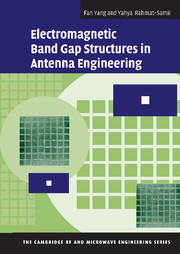Book contents
- Frontmatter
- Contents
- Preface
- Acknowledgements
- Abbreviations
- 1 Introduction
- 2 FDTD method for periodic structure analysis
- 3 EBG characterizations and classifications
- 4 Designs and optimizations of EBG structures
- 5 Patch antennas with EBG structures
- 6 Low profile wire antennas on EBG ground plane
- 7 Surface wave antennas
- Appendix: EBG literature review
- Index
- References
6 - Low profile wire antennas on EBG ground plane
Published online by Cambridge University Press: 06 July 2010
- Frontmatter
- Contents
- Preface
- Acknowledgements
- Abbreviations
- 1 Introduction
- 2 FDTD method for periodic structure analysis
- 3 EBG characterizations and classifications
- 4 Designs and optimizations of EBG structures
- 5 Patch antennas with EBG structures
- 6 Low profile wire antennas on EBG ground plane
- 7 Surface wave antennas
- Appendix: EBG literature review
- Index
- References
Summary
In the preceding chapter, the surface wave band gap of EBG structures was used to enhance the performance of microstrip patch antennas. Another important property of EBG structures is the phase response to the plane wave illumination, where the reflection phase changes from 180° to −180° as the frequency increases. In this chapter, we utilize this property to improve the radiation efficiency of wire antennas near a ground plane. Consequently, a novel type of low profile antennas referred to as wire-EBG antennas is proposed [1–2]. A series of design examples are illustrated with diverse radiation characteristics.
Dipole antenna on EBG ground plane
Comparison of PEC, PMC, and EBG ground planes
In wireless communications, it is desirable for antennas to have a low profile configuration. In such a design, the overall height of the antenna structure is usually less than one tenth of the operating wavelength. A fundamental challenge in low profile wire antenna design is the coupling effect of a nearby ground plane.
To illustrate this effect, let's examine the performance of a simple dipole antenna near three different ground planes, namely, perfect electric conductor (PEC), perfect magnetic conductor (PMC), and electromagnetic band gap (EBG) ground planes, as shown in Fig. 6.1. The dipole is horizontally positioned in order to achieve a low profile configuration [3–4]. The dipole length is 0.40 λ12 GHz and its radius is 0.005 λ12 GHz, while λ12 GHz, the free space wavelength at 12 GHz, is used as a reference length to define the physical dimensions of the antenna, ground plane, and EBG structure.
- Type
- Chapter
- Information
- Electromagnetic Band Gap Structures in Antenna Engineering , pp. 156 - 202Publisher: Cambridge University PressPrint publication year: 2008

